On January 1st, 1979, I stepped on a plane at Dulles International Airport tfor what was supposed to be a 4-6 week consulting job in Brussells, Belgium. Nearly a year later, I finally returned home. During that time, I may have shot as many as 10,000 slides using my venerable Nikon F and it's companion Nikkormat. Two-thirds of those were taken at the Royal Museum of Musical Instruments of a variety of early keyboard instruments as well as old pipe organs from around the countryside. The images you see here are, mercifully, from the other third of the set.
Another of my favorite images, this is of the steeple over the Town Hall on the Grande Place in Brussells, a 14th century stone edifice. Another of those serendipitous shots, the vivid colors in the sky behind lasted for only a few minutes, and I have never seen skys like this since. I shot it from the steps of the Cathedral of St. Michel in September of 1979. Later, when printing the negative, I was chagrined to find several small spots on the slide which I was unable to clean, no matter how hard I tried. Finally, I examined the slide under a microscope and was surprised to discover that these "dots" were, in fact, small helium-filled balloons being released by a group of school children. Under each balloon was tied a small postcard with a stamp and the child's return address.
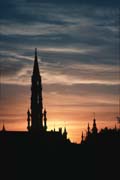
Nikon F, Nikkor 105mm, Kodachrome 25
Taken the same evening as the sunset view of the Grande Place, above, this is a shot looking up the spires of St. Michel. The sky directly overhead as crystal clear and a polarizing filter made the deep blue sky almost jet black. The harsh lighting and darkened sky and shadows resulted in a stark, almost out-worldly image.
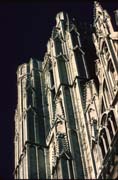
Nikon F, Nikkor 105mm, Kodachrome 25
An hour's train ride north and west of Brussells is the medieval town of Brugge. This is an ancient trading city a few miles insland from the North Sea. The town is largely untoiched from its heyday of a few centuries ago, and is crisscrossed by many small canals. Today, Brugge is a university town as well as a tourist stop, though I find the quiet pace and smaller, more leisurely tourist scene more attractive than the noisy, crowded bustle of, say, Venice. This is one of the many little canals, located near the University. This picture was taken in early November of 1979.
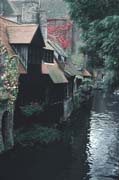
Nikon F, Nikkor 105mm, Kodachrome 64
Just outside the center of Brugge is a convent. It's a small, almost completely self-contained entity, with neat white buildings and walls surrounding a large central green. Once inside, the noise of the traffic outside is almost undetectable. I found it curious that all the trees lean in the same direction, due to the influence of the prevailing winds blowing in off the North Sea.

Nikon F, Nikkor 50mm, Kodachrome 64Belgium and the other Low Countries lie adjacent to the North Sea, where a lot of moisture that blows in off the North Sea year round. This results in the legendary pea-soup fogs Belgium is famous for as well as some of the most incredible hoarfrost I have ever seen. When it's not completely socked in, the skys are almost always milky, laden with moisture. The resulting light is very soft and flattering to many of the old structures around the country. Crisp, clear days, as we often see in autumn in New England, are a rarity in Belgium. Belgium is also considerably farther north than any major city in the continental United States, farther north even that cities such as Montreal, Canada and most of Nova Scotia. The sun never gets high in the sky and, during the winter, the nights are long dark (save for the blinding sodium-vapor highway lighting) and the days are fleetingly brief.
Along with the many little canals, Brugge is crisscrossed by narrow streets and alleyways. Most of the latter wouldn't qualify in the United States as a walkway, but for Europeans (and especially European students), they are perfect for the vehicle du jour, the uniquitous bicycle.
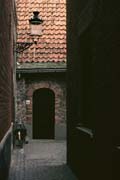
Nikon F, Nikkor 50mm, Kodachrome 64
About 100 km southeast of Brussels, near the city of Namen (Namur), is the Abbey of Maredsous. New by European standards (less than 200 years old), it's a peaceful retreat. Tourist are invited to stop by. I was there one sunny summer afternoon and, upon entering the courtyard, was intrigued by the large numbers of people sitting and, well, sprawled on the grass, sleeping. We walked around the abbey and, finally, found our way to the cafeteria, where they served thick sandwiches of smoked ham and cheese on dense, heavy bread, along with a big mug of beer made by the monks. The sandwich was hearty and fillng, and the beer was thick and heady, not at all unpleasant, and quite strong. A very satisfying meal, to be sure. When we were done, we strolled out onto the grass and sat down for a brief rest before setting off, and were quite surprised to find ourselves waking up from an hour-long nap. Those monks make a killer brew, to be sure. The shot you see here is of the long, covered walkway where the monks can be seen strolling, saying their daily prayers.

Nikon F, Nikkor 25mm, Kodachrome 64
The center of Brussels is old, very old. There are still remains of the original Roman wall that surrounded the small town 1000 years ago. But Brussells is a mix of the very old and the very new, with everything in between to be found. Many of the outlying portions of the city where built up during the early part of the 20th century, and echibit some fine examples of the art deco style. I would often wander about the city on foot, camera in hand, looking for interesting patterns in the building, as seen here. Medium telephoto lenses help compress the perspective, and unify the repetitive patterns found. The subtle pastels and earthtones decorating them further enhanced the images.
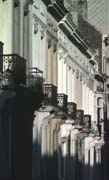
Nikon F, Nikkor 105mm, Kodachrome 25
In the spring of 2001, we had the opportunity to accompany several students from the German studies program at our kids school on what would end up being a whirlwind tour of Germany. We arrived in Köln the day before Easter. In the cathedral, I found this gentleman wandering about, carefully studying each of the many stain glass windows. I followed him, biding my time, knowing that he would eventually arrive at the point where I thought there was a picture. Sure enough, he obliged, even striking a cooperative pose for me. Outside, it was heavily overcast and quite dark. The resulting exposure was about 1/4 second at f/5.6. With no tripod, I had to carefully find a spot on one of the pillars to hold the camera against to get the exposure. Because the lighting is such an unpredictable mix of color, skylight through stained glass, interior artificial light with a mix of tungsten, mercury flourescent, and more, often no filtration is no worse than trying to achieve a "correct" color balance.

Nikon 6006, 35-70 zoom at 35mm, Agfa HDC200+
For a substantial portion of the time I lived in Belgium, I stayed in a little village called Corbais, some 40 km south and east of Brussells. This is farm country, and the surrounding plains are dotted with farms and villages. It's not unusual to find modern tractors parked in or next to 500 year old stone buildings.

Nikon F, Nikkor lenses, Kodachrome 64
Back to the Grande Place in Brussells, this photograph was taken on a stormy night with almost no one in the normally crowded square. This is the town hall, the spire of which is seen in the first picture above. The gold color is a result of the use of low-pressure sodium vapor lighting, used widely throughout Belgium. I took two pictures that night, the other with my Nikkormat using Ektachrome. Kodachrome and Ektachrome can react very differently to narrow-spectrum light sources like this: neither accurately renders the strange colors. Kodachrome will often display this golden color, not entirely unattractive, while Ektachrome rendered the building a most unattractive olive green, almost the color of bile.
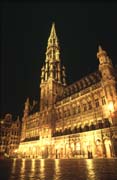
Nikon F, Nikkor 24mm, Kodachrome 64